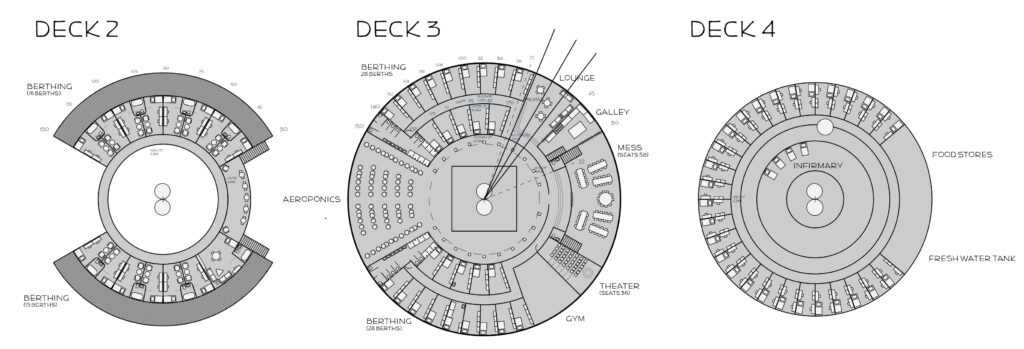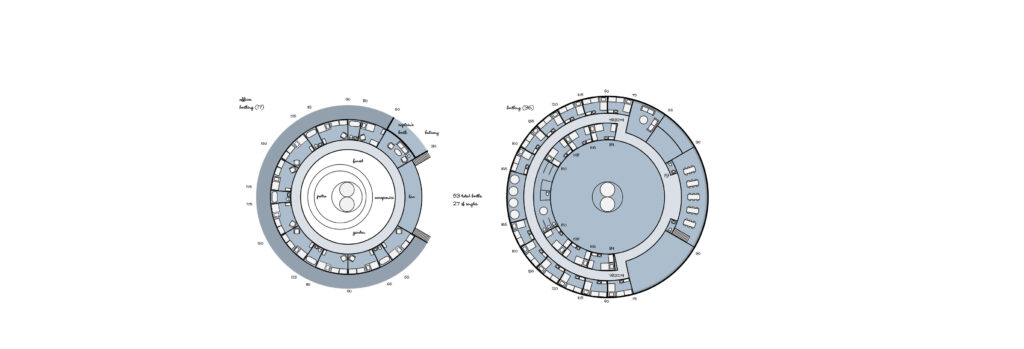The Wisteria, the spaceship where the player in Tinselfly will spend much of their time, is too big.
It was supposed to be the size of the Normandy from Mass Effect: something with a total crew and passenger count of around 25, maybe 5 decks, tops. A small, unremarkable ship.
Somehow, I messed something up with my size estimates or unity conversion or something and ended up with a design that was 260 meters long.

It was only after I’d completed a good bit of modeling that I realized that this what not at all what I wanted or, more to the point, could achieve. So I removed sixty percent of the interior volume and cut the length down to a mere 192 meters.

And it was only after doing even more modeling that I realized, it was still too big. But I’m kind of stuck with this ship now; I’m about halfway through modeling the interiors.
So I need to fill these interiors, and figure out details for a couple other ships in the Tinselfly universe, too. But before I dive into modeling and adding random stuff, I thought it would be good to take a step back and figure out how ships operate in this universe. Like, in more detail than will likely be expressed in-game, even though it has always been the plan that you will see every deck, and literally every not-a-bedroom room on the Wisteria (and even then, you’ll see a representative sample of the bedrooms).
I’m not especially fond of this kind of work, but ultimately, it will probably speed up the work of finishing these ships and make them more engaging environments at the same time. Besides giving myself specific goals for modeling and set dressing, this will certainly help with puzzle design, and effectively communicating what I want to communicate, about what it’s like on one of these ships.
Because it might not be what players expect.
This is space opera; this is melodrama; this is an optimistic science fiction universe with science ships running around… but this is not Star Trek. Much of what follows here and in subsequent posts will be based heavily on what I understand to be modern NOAA survey ship operations… and much of this will be me making this up as I go, trying to look directly at how my assumptions are still based heavily on Star Trek.
Ship life in the Tinselfly universe is intended to be, in sharp contrast to the visuals, quite mundane and grounded in the real world. These are a ships with kind of mundane jobs to do, and that’s kind of important, thematically, to the story.
There’s a lot of work to do here, and it will take some time–and multiple posts. So let’s get started with some background information.
Mission
The Wisteria’s typical duties include:
- Making maps of both land and oceans, so that ground, air and water-based craft can navigate newly colonized worlds safely;
- Measuring the health of atmospheres and oceans, to ensure that colonization and resource gathering efforts do not adversely impact the environmental health of these worlds;
- Measuring alien life populations, which eventually informs how much fishing/hunting/etc., if any, is permitted each year on each world;
- Providing space, support, transportation and equipment to civilian scientists who would like to perform their own research projects wherever the ship happens to be going.
That last point is in many ways the most important. The crew of the Wisteria, generally speaking, does not do research. They don’t explore. They don’t solve alien mysteries. They don’t even really have goal-oriented missions like you’d hear described in the opening captain’s log on a Star Trek episode, kicking off the plot for the next hour. They go to places where a variety of people need to do research, for a variety of different reasons.
The crew runs and maintains the ship, and while they collect routine survey information, their first priority is providing a service to the civilian scientists onboard.
* * *
Complement
So far, the Wisteria has beds for 49 people. There could be more, depending on what details I add to the unfinished parts of the ship, but at 49 beds that probably means there would be around 24 crew and 25 researchers. Let’s say that’s like up to ten independent teams of researchers, ten different research projects going on? That sounds like a decent number I think.
Considering the size of the interior spaces of the Wisteria, the crew compliment feels a bit sparse but there’s plenty of space in the as-yet-mostly-empty bottom section of the ship, enough to easily double the number of beds, and researchers, and crew. So we’re probably looking at more like 100 people total: 50 crew, and a score of research teams.
More specifically, for the crew, here’s a possible breakdown:
- 1 captain.
- 1 XO.
- 1 chief scientist.
- 12 deck hands.
- 12 engineers.
- 6 survey team members.
- 2 tech support people (the player character is one of them).
- 6 cooks / cleaning staff.
- 4 bridge watch people.
- 1 botanist for the aeroponics bay.
- 2 doctors/nurses.
That sounds like a lot now. It changes the story a little. Even if every plot point is the same and we focus on the same core characters, a story about 24 people in trouble is a little different than a story about 100 people in trouble.
Modeling all of those people is tedious, but not difficult; and while I’m worried about animating all of them, 100 people will probably use not too many more unique animations than 24 would have. Mostly, I’m worried about the game performance; animated people are very taxing on game engines.
I’ll probably have to do quite a bit of optimization to make sure people you can’t see aren’t drawn or animated… which again… I would probably have needed to do anyway.
* * *
Next up: clothes, daily routines, and the bridge. Stay tuned!